 |
|
Camera Obscura by John Joseph Adams |
May 2006
High expectations Burned again
Horrormeister John Carpenter attempts to make an extraordinary film about an
extraordinary film, but doesn't quite pull it off.
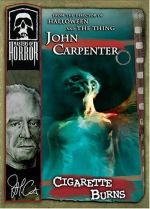
Masters of Horror: Cigarette Burns
IDT Entertainment
Director: John Carpenter
Writers: Drew McWeeny & Scott Swan
Starring: Norman Reedus, Udo Kier, etc.
DVD Release Date: March 28, 2006
Rated NR / 55 minutes / 2006


 (out of four)
(out of four)
Note: Cigarette Burns is the second of two Masters of Horror episodes currently available on
DVD. Rather than delve into the origin of the series a second time, I refer you to my earlier
review of Dreams in the Witch-House for the requisite background information.
Film connoisseur Kirby Sweetman (Reedus) is hired by creepy millionaire Mr. Bellinger (Kier)
to find an incredibly rare print of a film called Le Fin Absolue du Monde (The Absolute End of
the World). It only played once at an international film festival, and when it did, it
apparently caused violence to erupt in the theater. When the director, Hans Backovic, tried
to get it out of the country, the government seized it and destroyed it. Alas, it was a work
in progress, so it was his only print. 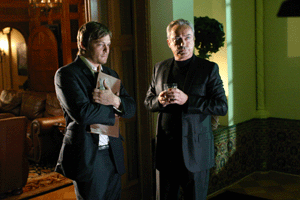
Or so the story goes. Apparently it was not destroyed, and Bellinger wants it. Kirby doesn't
believe it's really out there, but Bellinger has an "unimpeachable" source, which, apparently,
he keeps chained and shackled in a room adjacent to his study.
Bellinger, in one of the early film's missteps, shows his source to Kirby; it's an angel, it's
wings brutally hacked off-wings, I might add, that we saw hanging on the wall of Bellinger's
study (a prop from the movie, he'd explained). The angel stands, morosely, spinning on a
rotating pedestal, while bound to chains its frail body has no chance of escaping. Bellinger
commands it tell Kirby what it told him, namely that it (and others like it) were "bound to
the negative like soul to flesh," so he would know if it had been destroyed.
So Kirby takes the case. His first step is to track down and speak with a film critic A.K.
Meyers, who is one of the only survivors to have seen the film. He's been living as a recluse
in upstate New York (in director John Carpenter's hometown of Carthage, as it happens). In
a review, Meyers says "Le Fin Absolue du Monde is not a movie but is more like a bullet fired
directly into the collective brainpan of all those assembled and the only rational response is
violence." He goes on to tell Kirby that "Backovic was a terrorist. He abused that trust we
place in filmmakers. He didn't want to hurt his audience. He wanted to destroy them
completely."
Meyers gives Kirby a recorded interview Meyers did with Backovic at the festival prior to the
screening. Kirby listens to the tapes, and as he does so, he starts to experience strange
visions-haunting visages of his dead girlfriend punctuated by jarring circular images, not
unlike those in the film The Ring. They're called cigarette burns, we learn, and people who
have pursued or seen the film all report the phenomenon. They're called this because they
resemble the "cigarette burns" that appear in the top corner of film reels, which serve as
notification to the reel attendant that he needs to change reels. 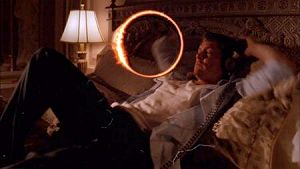
Undeterred, not only because of his suddenly strong desire to see the film, but also because
of his urgent need of the load of cash Bellinger is offering, Kirby goes to Paris to see what
else he can learn there. There, Kirby follows some other leads, which put him in grave peril,
but eventually leads him to the film.
He brings it to Bellinger...and bad things happen.
Unlike Stuart Gordon's entry, Cigarette Burns is actually quite scary at times, with some
indisputably horrific scenes. However, like Dreams in the Witch-House, it also aims high
and falls short (though not quite as short) of the mark.
The acting is pretty solid; Reedus (Kirby) has an affable blandness about him, yet he
manages to get the job done. He doesn't show a lot of emotion despite the inexplicable
weirdness surrounding him, but his character is interesting, and while his performance
doesn't raise the bar, it reaches it at the very least. Kier (Bellinger), however, is way, way,
way over the top in his performance. I think he's kind of doomed to always be typecast as a
somewhat creepy old guy in movies, but in this case he lays it on a bit too thick.
Above, I made reference to one of the film's missteps–when Bellinger shows the angel to
Kirby. If this were a novel or short story, any good editor would have killed that scene; it
was completely unnecessary and only serves to dumb-down the plot. Why should Kirby
need the proof of an angel to go on this filmic treasure hunt? Bellinger offers to pay all his
expenses and throws in $200,000 on top of all that. Seems to me, Kirby had 200,000
reasons to say yes, especially since he needs that money to repay a debt. And wouldn't the
angel being revealed at the end have made it a much cooler plot point? 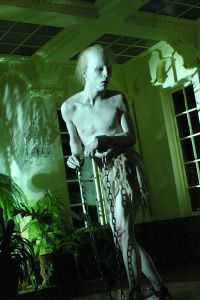
Carpenter (and/or the screenwriters) made several other questionable choices throughout
the film. One is a diversion to a maniac film collector's home, which seems to be nothing
more than an excuse for grotesque bloodshed. Another is the cigarette burns themselves–the phenomenon that pursuers of the film begin experiencing. It doesn't really make any
sense and seems to be thrown in only for the visual effect.
Yet another misstep is when Bellinger's Asian butler thrusts a four or five inch blade into one
eye, then the other. This strikes me as somewhat impossible–wouldn't the knife have gone
into his brain with the first stab? If that didn't kill him instantly, would he have still be
coordinated enough afterward to stab out his other eye? And then stick around long enough
to assist in a critical plot point?
Not to mention the fact that Kirby ends up finding the film in the possession of Backovic's
widow. If you were looking for a rare film, don't you think the filmmaker's widow might be
one of the first people you'd check with? Of course, if he'd done that, the movie would have
been a lot shorter.
The film within the film, Le Fin Absolue du Monde, is only seen in bits and pieces, which is of
course necessary, by design. They couldn't well tell this story and make a coherent fictional
film too. Also, how to depict something that's supposed to be so viscerally horrific that "the
only rational response is violence"? The bits and pieces we see are interesting and dark, but
the viewer doesn't get any idea of what the film is actually supposed to be about. There
doesn't seem to be any continuity in the scenes we see–it's just a jumble of random
images. The creepy video in The Ring made more sense (and was creepier to boot). 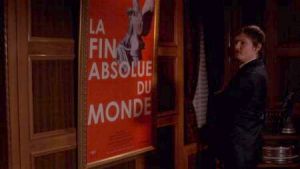
I initially loved the premise, but quickly realized that it's quite derivative The Ring. It also
reminded me a lot of Laird Barron's excellent recent novella "The Imago Sequence" (which
was far superior to any work mentioned in this review), though I don't think the filmmakers
could have read it pre-production, so the similarities are almost certainly a coincidence.
Though these two factors diminished by admiration for the film somewhat, I still found it to
be an enjoyable and laudable viewing experience...even if I did want to do a rewrite on the
script so that I could see the film I wished this was.
And in the words of Kirby: "I don't want to see an ordinary film. I want to see something
extraordinary." That was my problem with Cigarette Burns. But you've got to give
Carpenter points for having the guts to put a line like that in his movie.
DVD Extras
Available Audio Tracks: English (Dolby Digital 5.1), English (Dolby Digital 2.0 Surround)
Commentary: John Carpenter (director), Drew McWeeny & Scott Swan (writers)
Featurettes: "Celluloid Apocalypse: An Interview with John Carpenter"; "Behind The
Scenes: The Making of Cigarette Burns"; "Working With a Master: John Carpenter"; "On Set:
An Interview with Norman Reedus"
DVD-ROM: Original Screenplay, screensaver
Misc.: John Carpenter biography (onscreen text); Still Gallery; Trailers


 (out of four)
(out of four)
As with the Dreams in the Witch-House DVD, Cigarette Burns' extras are an interesting
bunch. The featurettes are all well-worth your time if you're a big Carpenter fan, or if you're
interested in learning how movie magic is brought to life on the big–or in this case, small–screen.
Carpenter comes off as a bit of a blowhard in parts of the various interviews, but he's an
engaging speaker and offers some interesting insights into his process. He also curiously
sort of undermines his entire film by calling one of its primary themes–that a film in the
wrong hands can be a deadly weapon–a terrible cliché.